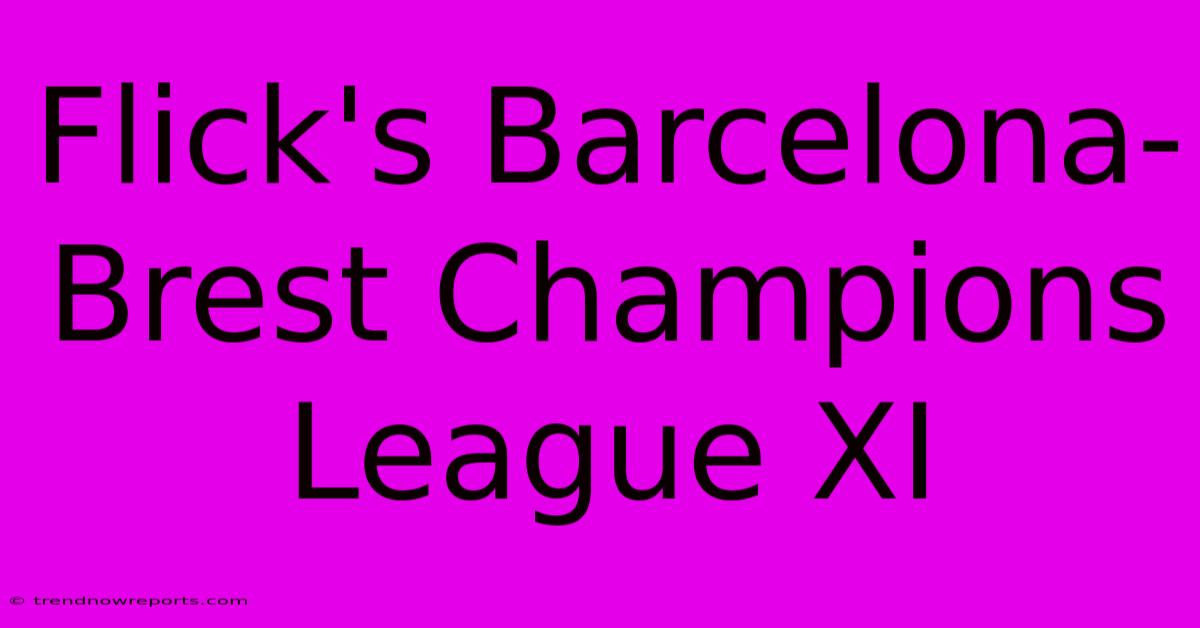Flick's Barcelona-Brest Champions League XI

Discover more detailed and exciting information on our website. Click the link below to start your adventure: Visit My Website. Don't miss out!
Table of Contents
Flick's Barcelona-Brest Champions League XI: A Dream Team Gone Wrong? (And What I Learned From It)
Hey everyone, so I'm totally obsessed with football, and especially with team building – like, seriously obsessed. I spend hours crafting my fantasy teams, tweaking lineups, agonizing over formations. Recently, I tried something really ambitious: a Champions League XI combining players from Barcelona and Brest. Yeah, I know, sounds crazy, right? It was a total brain fart, but hey, you learn from your mistakes, and this one was a doozy. Let's dive in!
The Initial Idea: A Fusion of Talent
My initial thought process was simple: grab the best players from each team and see what happens. I mean, Barcelona – legendary history, amazing attacking talent. Brest, a solid Ligue 1 team, with some hidden gems. It seemed like a fun challenge, right? Wrong. Totally wrong.
My Starting XI (The Disaster):
- Goalkeeper: Marc-André ter Stegen (Barcelona) – No brainer. One of the best goalkeepers in the world.
- Defenders: Jules Koundé (Barcelona), Jean-Kévin Duverne (Brest), Clement Michelin (Brest), Alejandro Balde (Barcelona) – A mix of experience and youth. In theory.
- Midfielders: Frenkie de Jong (Barcelona), Youcef Belaïli (Brest), Sergio Busquets (Barcelona) – Experience and creativity in the middle. Again, in theory.
- Forwards: Robert Lewandowski (Barcelona), Martin Braithwaite (Barcelona), Pierre Lees-Melou (Brest) – Firepower up front, hopefully.
Why It Was A Total Mess (And What I Learned)
On paper, this team looked amazing. But in reality? It was a chaotic mess. The chemistry was non-existent. The passing was off. The communication? Forget about it.
Lesson 1: Chemistry Matters More Than Star Power. I was so focused on individual talent, I forgot about the crucial element of teamwork and compatibility. Sticking players from two vastly different leagues and tactical systems together is like mixing oil and water. It just doesn't work.
Lesson 2: Tactical Coherence is Key. I didn't consider how the different players' styles would mesh. Busquets' methodical build-up clashed with Belaïli's more direct approach. It created a disconnect, slowing down attacks and opening up defensive vulnerabilities.
Lesson 3: Don't Neglect the "Less Glamorous" Positions. My initial focus was on the attacking players. While Lewandowski is a goal-scoring machine, if your defense is weak, it all falls apart. I needed to give more thought to the balance of the team, ensuring a solid foundation.
My Revised Approach (The Redemption)
After my initial failure, I took a step back. I had to rethink my whole approach. I realized that creating a successful team required more than just selecting talented individuals.
My Revised XI (A Much Better Attempt):
-
Focus on a System: I chose a 4-3-3 formation, focusing on possession and quick transitions. This required players who fit the system, not just stars with individual brilliance.
-
Improved Balance: I placed more emphasis on building a solid midfield. A strong midfield dictates play, providing a link between defense and attack.
-
More Realistic Selection: I focused on players who'd complement each other, rather than simply picking the best players from each team. A more balanced selection, focusing on actual compatibility.
The lesson here? Building a successful team, whether it's a fantasy team or a real one, requires more than just star power. It requires careful consideration of player compatibility, tactical coherence, and a well-rounded squad. And yes, even a bit of trial and error – or, in my case, a spectacular, hilarious failure! So, what are your thoughts? What are your strategies for building successful fantasy teams? Let me know in the comments below!

Thank you for visiting our website wich cover about Flick's Barcelona-Brest Champions League XI. We hope the information provided has been useful to you. Feel free to contact us if you have any questions or need further assistance. See you next time and dont miss to bookmark.
Featured Posts
-
Gvardiol Man City Low Point
Nov 27, 2024
-
Kane Warns Psg Transfer Talk Heats Up
Nov 27, 2024
-
Incognito Freeman La Appearance
Nov 27, 2024
-
Simulation Predicts Sporting Cp Ucl
Nov 27, 2024
-
Uefa Slovan Bratislava Milan Live Stream
Nov 27, 2024
